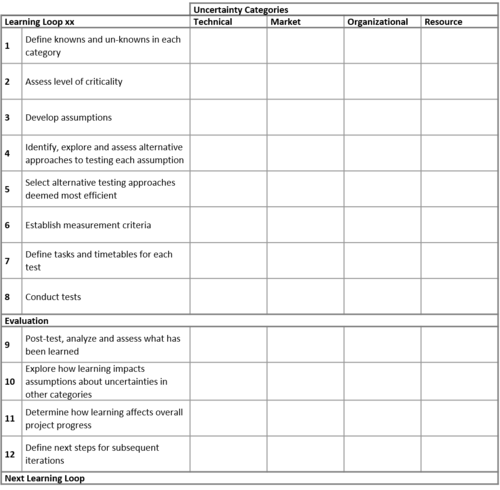Learning plan
by John Fritz (s202967)
The learning plan is a tool to overcome the challenge of making sound decisions while facing uncertainties. In principle, a learning plan is a document that can be used by a project team to resolve uncertainties in the four relevant categories: market, technical, resource, and organizational uncertainty. Over the life cycle of a project, the project team systematically tests assumptions to their uncertainties to build up decision-relevant knowledge throughout several iterations of the learning plan, also called learning loops. This approach is particularly useful in high uncertainty projects, for example for radical innovations, where other approaches to project planning could lead to early abortion of the idea. In general, learning from experience is one of the key characteristics of successful projects as it counters project uncertainty and facilitates project planning based on facts rather than assumptions which in the case of the learning plan are gained through rapid, low-cost experiments.
Contents |
Big Idea of the Learning Plan
Relevance for Project, Program and Portfolio Management

The learning plan is a framework to facilitate a learning process that systematically turns unknowns into knowns. It is applied at the planning stage of a project and gets continuously revised throughout the project life cycle whenever there is a lack of decision-relevant knowledge. As all projects encounter uncertainties that introduce both threats and opportunities, learning from experience is one of the principles of successful project management in the PRINCE2 framework [2]. Through the learning plan, a project team can proactively fill its knowledge gaps and gain experience through experimentation. While the focus in this article is on project management, learning is also a key principle of program and portfolio management. The British standard for managing successful programmes [3] describes a program as a learning organization that is subject to continuous improvements with increasing experience. It also states that, due to the higher complexity and degree of uncertainty, programs are typically even more reliant on an efficient learning process than their single constituent projects. Apart from the application in the area of project, program, or portfolio management the learning plan tool is also popular for planning the professional development of individuals. As this will not be the focus of this article, the annotated bibliography points towards a further reading in this regard.
Key Characteristics of the Learning Plan
According to Leifer et al. [4], a learning plan has the following key characteristics:
- It catalogs uncertainties
- It connects uncertainties with assumptions
- It prioritizes uncertainties based on their criticality
- It presents testing approaches to resolve critical uncertainties
- It documents the progress of a project in terms of learning outcomes and their consequences
While a learning plan has no universal format, a basic learning plan should consist of at least two sections. In the first section, the participants of the learning process catalog uncertainties in four categories: market, technical, resource, and organizational uncertainty. For the most critical ones the team then develops assumptions that get tested and, if disproved, turn into a new assumption or, if proved, into a fact. In the second section, this is then followed by an evaluation of the learning where results are reviewed and, if necessary, new assumptions and tests are developed to initiate another iteration of the learning plan. The learning plan is therefore continuously revised to adapt to learning outcomes and new circumstances. Figure 1 shows a template of a learning plan. In addition to a simple document, it can be beneficial to support the learning process with a digital project or task management tool, for example, to document tasks and responsibilities for assumption tests.
Learning as a Concept to Counter Project Uncertainty

A common characteristic of projects is that they all encounter uncertainty, especially in the early planning phase. As projects mature the project team will gain experience which increases the availability of decision-relevant knowledge. Nevertheless, this will never fully eliminate all unknowns. Uncertainty is seen as the cause of project risk which is defined as "an uncertain event or condition that, if it occurs, has a positive or negative effect on one or more project objectives" [5]. Appropriate risk management is one essential pillar to identify, assess, and control uncertainty in projects [2]. Moreover, systematic and pro-active ways of building knowledge to resolve uncertainties are another way to support effective decision-making.
The process of acquiring new, or modifying existing, knowledge, behaviors, skills, values, or preferences based on experience is called learning [6]. Uncertainty through a lack of knowledge or information can therefore be reduced by an appropriate learning process [7].
The learning plan is a tool for project planning based on systematic learning which ideally results in uncertainty reduction. It is widely used for innovation projects, particularly for radical innovations, where the degree of uncertainty is typically very high. There, project teams can often only proceed based on assumptions they make. Over time, learning reduces the number of these assumptions and turns them into new knowledge. This in turn leads to a higher certainty in management decisions while projects mature. [4]
There are several established approaches to cope with project uncertainty. Figure 2 provides an overview of different project planning approaches - each associated with a certain degree of uncertainty where it proved most useful. Here, the learning plan is seen as the project planning framework that should be used in situations of highest uncertainty. While the degree of uncertainty ideally gets reduced throughout the lifecycle of a project and several iterations of the learning plan, other project planning approaches may take over. Moreover, there are also overlaps between different concepts. [4]
Application of the Learning Plan
The template in figure 1 shows the steps of the learning plan process in vertical and the categories of uncertainty that are found to occur in projects in horizontal direction. The latter refers to the multidimensionality of uncertainty. As an understanding of the dimensions of uncertainty is crucial for the successful application of the learning plan, they are further explained in the following. This is then followed by a detailed description of the steps of the learning plan process.
Dimensions of Uncertainty

Figure 3 shows the three dimensions of uncertainty in the context of project management described by O'Connor and Rice [8]: category, latency, and criticality.
Category
The first dimension, the uncertainty category, is dividing uncertainties into the four content areas technical, market, organizational, and resource uncertainty. In relation to the learning plan, the following learning objectives can be defined for each: [1]
- Market uncertainty: Learning about market drivers, value creation, and business viability
- Technical uncertainty: Understanding technology drivers, value, and economic feasibility
- Resource uncertainty: Accessing money, people, and organizational competencies
- Organization uncertainty: Gaining and maintaining organizational legitimacy
Projects can differ largely in their level of uncertainty in each category. Moreover, the uncertainties in different categories can interact with one another so that resolving uncertainty in one category can also have an effect on other categories. Splitting up the uncertainties into these categories helps a project team analyzing the entire spectrum of uncertainties and avoiding the pitfall of focusing only on such uncertainties that the project team is most comfortable with. For successful projects, it is particularly important to reduce uncertainty and accumulate learning over all categories. In practice, managers were often found to focus on technical uncertainties instead [4].
Latency
The second dimension of uncertainty, latency, refers to the degree to which uncertainty can be anticipated. The higher the latency, the more difficult is it to perceive the uncertainty and to find appropriate assumptions for it. As a result, high latency uncertainties may not be resolved with assumption testing before the uncertain event occurs. The concept of latency is not explicitly noted in the learning plan. It is important nevertheless as project teams need to put effort into cataloging also those uncertainties that are difficult to anticipate and that might have a large influence on the progress of the project. Moreover, they need to be flexible in their learning approach as they need to adapt the learning plan to unanticipated events as the project matures.

Criticality
The third dimension of uncertainty refers to the criticality of the uncertainties. Uncertainty is found to be critical if it is a potential showstopper for the project. In order to ensure a project's success, these need to be resolved immediately. On the other hand, an uncertainty that is routine does not threaten the survival of a project. The assessment of criticality takes place in the second step of the learning plan process. The most critical uncertainties should be targeted by assumptions and tests as soon as possible.
The dimensions latency and criticality are found to interact with one another as shown in figure 4. The uncertainties which are anticipated and routine are fairly easy to handle as they are known from the project start and can be targeted with an appropriate set of assumption testing approaches. Unanticipated but routine uncertainties occur without prior perception but due to their routine property can be treated quickly through the next iteration of the learning plan. Anticipated showstoppers need to be targeted immediately with a more comprehensive set of actions while unanticipated showstoppers need to be addressed aggressively upon occurrence which may require a substantial amount of resources. The occurrence of uncertain events during a project's lifecycle is not necessarily negative but can as well be an opportunity for further progress beyond the original plan.
the Steps of the Learning Plan

The learning plan can be applied at every life cycle stage of a project. Nevertheless, it might be most useful in the initial planning phase or fuzzy front-end period to create the relevant knowledge needed for management decisions. The learning plan process as described by Rice et al. [1] is divided into two main parts. First, a learning loop is conducted and second, the learning from this loop gets evaluated. In the following, the steps shown in the template in figure 1 are explained in more detail. Another example of a template for a learning plan is shown in figure 6. Here, each uncertainty category gets its own sheet which can improve the clarity of the cataloging process. Other than that it essentially addresses the same steps of the learning loop while specifically emphasizing the "knowns" of the project team which have to be supported by evidence.
Conduct Learning Loop
Step 1: Following the steps of the learning plan template in figure 1, each iteration through the learning plan starts with the identification of explicit uncertainties in all four uncertainty categories. It can also be beneficial to write down what is already known at this step of the process. Figure 5 provides a non-comprehensive list of uncertainties that potentially arise in projects that can serve as a starting point for creative thinking.
Step 2: The cataloging of uncertainties is followed by an assessment of their criticality to identify potential showstoppers and to make a decision on where to learn first. Most often this is done with the levels high, medium and low.
Step 3: In the next step, the project team needs to develop assumptions while potentially focusing on the most critical uncertainties. Assumptions are accepted as true as long as they are not disproved. While a project can potentially progress based on assumptions, a false assumption can have serious consequences for the outcome of a project. It is therefore key to the learning plan that assumptions get tested early on to either turn them into facts or find better suitable assumptions.
Step 4: The assumption testing is done through the remainder of the steps of a learning loop starting with the identification, exploration, and assessment of alternative testing approaches to each assumption. The more valid testing alternatives a project team can think of at this stage, the better.
Step 5: The most efficient testing approaches out of the number of alternatives are then selected in terms of “learning per dollar spent per time”. This can be understood as the value of the cumulative learning outcome that can be expected from the test compared to the costs it causes. If no testing approach is found to deliver sufficient value, the project can either continue based on the assumption or managers might decide on terminating the project. The overall goal is to maximize learning while minimizing spending and therefore find the most inexpensive way possible for building new knowledge.
Step 6: Another important step is to define the measurement criteria for either proving or disproving an assumption through the test. These are highly dependent on the assumption itself and can be of both quantitative and qualitative nature. Moreover, there has to be an agreement on the objectives for each test between the project team and those who evaluate a team's progress.
Step 7: In the following, the timetable gets defined and resources get assigned to the tests. This includes defining a task responsible for each of the tests. The tests do not necessarily have to be executed by the project team but can as well be outsourced to other parts of the company or even external providers.
Step 8: Finally, the tests get conducted. The test outcomes are also to be noted in the learning plan.
Evaluate Learning
The evaluation of the learning loop should be done by the project team together with the oversight or project evaluation board that is responsible for evaluating the progress of the project. The following steps are part of this process:
Step 9: The evaluation starts with an analysis and assessment of the test results and whether they prove or disprove the assumptions based on the measurement criteria. In case an assumption is disproved it needs to be evaluated which other assumption might then be more appropriate to the respective uncertainty. Moreover, the results of the assumption tests can also lead to entire new uncertainties that require assumptions to be made in the next learning loop.
Step 10: Then, as uncertainties in the four categories potentially interact with one another, it has to be further assessed if the learning from testing one assumption has potentially affected assumptions about uncertainties in other categories.
Step 11: Afterwards, the learning gets evaluated in terms of its effect on the overall project progress. This includes an evaluation of the overall learning outcome and if it justifies subsequent learning loops or project continuation. This step is important as unexpected insights from the tests can likely set a project back or even accelerate it.
Step 12: Finally, the steps required for following learning loops get defined. In practice, teams are found to have taken three to four learning loops until they reached an appropriate level of certainty to apply another approach to project planning. Moreover, throughout the project life cycle, the learning plan needs to be continuously revised to monitor what has been learned and what still needs to be learned.
Example Application of the Learning Plan

The following is an example application of the learning plan template in figure 6. The focus is on the market category of uncertainty. When the learning plan is applied at a company, it is often included in a comprehensive report that, next to the templates documenting specific learning loops, also documents additional information like:
- Authors: list of authors of the learning plan
- Opportunity Description: description of the opportunity of the project for which the learning plan is used
- Potential Market Areas: description of potential market areas for the opportunity
- Executive Summary: summary to management with critical unknowns and learning results
The core part of the report is then filled with information about the learning loops and their evaluation. Figure 7 shows a completed learning loop for the example case of a research institution that assesses the opportunities of teleportation. The lists of knowns and unknowns are non-comprehensive and need to be tailored to the specific project opportunity. As can be seen, the uncertainty with low criticality has not been assessed in this learning loop and may potentially be subject to learning in a subsequent iteration.
Benefits and Limitations of the Learning Plan
The learning plan has shown the following main benefits, according to a case study of Rice et al. (2008) [1]. In terms of project management, a learning plan is a systematic approach to project planning in highly uncertain environments. By this, it enables decision-makers to base their decisions on facts rather than assumptions. Through extensive documentation, the learning plan is also an effective tool for measuring project progress and the value of learning which can be communicated to senior management. Furthermore, the application of the learning plan showed a high cost-reduction potential as it prioritizes critical uncertainties and reduces project maturation time. Moreover, it develops project managers in terms of their ability to address all dimensions of uncertainty and their strategic thinking towards uncertainty reduction. Finally, the learning plan can be effective in shaping a corporate culture of admitting unknowns and making explicit assumptions rather than killing project ideas too early or mistaking assumptions as facts.
Nevertheless, the learning plan also comes with several limitations that are highlighted in the following:
The tool is less suitable for low uncertainty projects
The application of the learning plan methodology can be complex as it is focused on uncertainties and requires extensive creative thinking and documentation. In projects that face a lower level of uncertainty, the learning plan might therefore not be the most efficient planning approach to follow. Instead, project teams might choose other project management frameworks as listed in figure 2. For radical innovation projects, however, the learning plan can be a useful tool throughout the entire project as even the residual level of uncertainty remains high. In these cases, a project planning approach like for example the stage-gate-model tends to kill innovation too early as decision-makers at early stages are likely to be overwhelmed by the degree of uncertainty. [1][4]
Successful application is highly dependent on the experience of the project team
The learning plan is a systematic approach to project planning in highly uncertain environments. Due to this, the success of the learning plan is highly dependent on the members of the project team and the oversight board and their experience with uncertain (radical) innovation projects. The less experience a team has with this kind of project, the more likely is it that the learning plan does not provide sufficient support for project planning as many parts of the learning plan are based on subjective judgments. Over time, however, the effective application of the learning plan can improve both project management and project managers as they get accustomed to the approach and the uncertain environment. [1]
The goal of uncertainty reduction is complicated by a fluctuating uncertainty level
The first step of applying the learning plan is the definition of knowns and unknowns in the project area. Project teams can have a hard time cataloging uncertainties as many of them will be of high latency and emerge only in the course of time. As a result, the uncertainty level fluctuates a lot over the life cycle of a project and learning loops may not necessarily lead to uncertainty reduction. This in turn may make it difficult to get the required support from management to constantly reassess and apply the learning plan in a project. However, there is a general trend of uncertainty reduction from the application of the learning plan in various case studies of industry projects. [4]
The tool is limited to guiding project progress rather than controlling tasks
The main benefit of applying the learning plan is to be able to follow a structured approach to project planning in uncertain situations. The framework is used for monitoring and guiding the learning progress rather than controlling and directing tasks and responsibilities. It needs to be continuously revised to reflect on learning outcomes, changing assumptions, and emerging uncertainties. In this capacity, it helps in documenting the progress but does not provide guidance for example on how to find appropriate assumptions, how to identify the most efficient tests, or how to set timelines. This implies a substantial amount of subjectivity in how project teams execute the steps of the learning plan process. On the other side, this does also make the learning plan a very flexible framework that can be customized to the needs of any project team. [1]
The tool does not necessarily facilitate a long-term learning organization
Finally, the learning plan as a standalone framework can not ensure a learning organization. For this, a company must develop its learning capacities in the long term and pass on experience gained in one project to other projects. As mentioned in the PRINCE 2 framework for successful project management [2] learning from experience has to take place at the time of starting a project, as the project progresses as well as at project closure to pass on lessons learned. Therefore, a learning plan is rather inefficient in the long term when it is applied only in the context of one project without integration into a knowledge management system. In practice, however, it can be observed that the commitment to developing the capacity of learning is cyclic rather than long-term oriented. [4]
Annotated Bibliography
Enhance the theoretical understanding:
O'Connor, Gina and Rice, Mark (2013), 'A Comprehensive Model of Uncertainty Associated with Radical Innovation', Journal of Product Innovation Management, 30(S1):
This journal article reports the results of a longitudinal study of 12 radical innovation projects in 10 large established U.S.-based firms. The authors point out the characteristics of radical innovation projects in general and develop the multidimensional model of uncertainty presented in this wiki based on the experiences of the project teams in the case study. At several places, the authors point towards the importance of learning in the context of radical innovation projects. The article is particularly interesting for project managers interested in applied theory in the context of uncertainty reduction.
Garvin, David (1993), 'Building a Learning Organization', Harvard Business Review, July-August magazine:
This article elaborates further on the requirements of building a learning organization. In this regard, the author names five main activities that need to be practiced by the organization in order to achieve effective learning outcomes. This includes the activities of experimentation as well as learning from experiences which can be facilitated by the application of the learning plan. Following the explanations in the article, a project manager can get a better understanding of the different approaches to these activities which can help for example in finding the most efficient assumption tests.
Practical material:
Rice et al. (2008), 'Implementing a Learning Plan to Counter Project Uncertainty', MIT Sloan Management Review, 49(2), pp.54-62:
This journal article is the core resource for this wiki as it provides a template and additional guidance on how to apply the learning plan in an organization. Starting from a theoretical introduction to uncertainty and project planning approaches the authors point out the steps of the learning plan process from p.56 onwards, followed by two extensive case studies of companies applying the learning plan in practice. The latter is particularly interesting for project management practitioners that like to get a sense of how other project teams made use of the learning plan and what challenges they faced.
Carleton University, 'Developing a Learning Plan', Available at: https://carleton.ca/hr/wp-content/uploads/Learning-Plan.pdf (Accessed: 21.02.2021):
This document provides guidance on how to develop a learning plan in the context of professional development for individuals. This is substantially different from the application in the context of project management that is described in this wiki article. Besides a template for an individual learning plan, the document also provides guidance on the steps to a successful application as well as example learning experiences.
References
- ↑ 1.0 1.1 1.2 1.3 1.4 1.5 1.6 1.7 1.8 Rice et al. (2008), 'Implementing a Learning Plan to Counter Project Uncertainty', MIT Sloan Management Review, 49(2), pp.54-62
- ↑ 2.0 2.1 2.2 Axelos (2017), 'Managing Successful Projects with PRINCE2', TSO (The Stationery Office), 6th Edition.
- ↑ Axelos (2011), 'Managing Successful Programmes', TSO (The Stationery Office).
- ↑ 4.0 4.1 4.2 4.3 4.4 4.5 4.6 4.7 Leifer et al. (2000), 'Radical Innovation: How Mature Companies Can Outsmart Upstarts' - Results of the long-term Rensselaer Radical Innovation Research Project, Harvard Business School Press
- ↑ Project Management Institute, Inc. (2017), 'Guide to the Project Management Body of Knowledge (PMBOK® Guide)', 6th Edition.
- ↑ Gross, Richard (2010), 'Psychology: The Science of Mind and Behaviour', 6th Edition.
- ↑ Perminova et al. (2008), 'Defining Uncertainty in Projects - A New Perspective', International Journal of Project Management, 26, pp.73-79.
- ↑ 8.0 8.1 8.2 O'Connor, Gina and Rice, Mark (2013), 'A Comprehensive Model of Uncertainty Associated with Radical Innovation', Journal of Product Innovation Management, 30(S1).
- ↑ 9.0 9.1 Li-Ying, Jason (2020), Material from the course 42575 Technology and Innovation Management at the Technical University of Denmark, E20.
